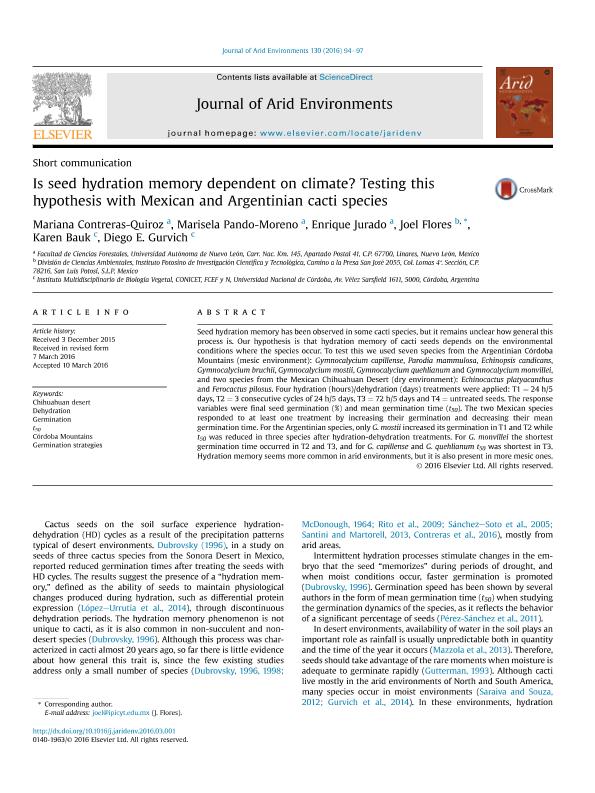Artículo
Is seed hydration memory dependent on climate? Testing this hypothesis with Mexican and Argentinian cacti species
Contreras Quiroz, Mariana; Pando Moreno, Marisela; Jurado, Enrique; Flores, Joel; Bauk, Karen ; Gurvich, Diego Ezequiel
; Gurvich, Diego Ezequiel
 ; Gurvich, Diego Ezequiel
; Gurvich, Diego Ezequiel
Fecha de publicación:
07/2016
Editorial:
Elsevier
Revista:
Journal of Arid Environments
ISSN:
0140-1963
Idioma:
Inglés
Tipo de recurso:
Artículo publicado
Clasificación temática:
Resumen
Seed hydration memory has been observed in some cacti species, but it remains unclear how general thisprocess is. Our hypothesis is that hydration memory of cacti seeds depends on the environmentalconditions where the species occur. To test this we used seven species from the Argentinian Cordoba Mountains (mesic environment): Gymnocalycium capillense, Parodia mammulosa, Echinopsis candicans,Gymnocalycium bruchii, Gymnocalycium mostii, Gymnocalycium quehlianum and Gymnocalycium monvillei,and two species from the Mexican Chihuahuan Desert (dry environment): Echinocactus platyacanthusand Ferocactus pilosus. Four hydration (hours)/dehydration (days) treatments were applied: T1 ¼ 24 h/5days, T2 ¼ 3 consecutive cycles of 24 h/5 days, T3 ¼ 72 h/5 days and T4 ¼ untreated seeds. The responsevariables were final seed germination (%) and mean germination time (t50). The two Mexican speciesresponded to at least one treatment by increasing their germination and decreasing their meangermination time. For the Argentinian species, only G. mostii increased its germination in T1 and T2 whilet50 was reduced in three species after hydration-dehydration treatments. For G. monvillei the shortestgermination time occurred in T2 and T3, and for G. capillense and G. quehlianum t50 was shortest in T3.Hydration memory seems more common in arid environments, but it is also present in more mesic ones.
Archivos asociados
Licencia
Identificadores
Colecciones
Articulos(IMBIV)
Articulos de INST.MULTIDISCIPL.DE BIOLOGIA VEGETAL (P)
Articulos de INST.MULTIDISCIPL.DE BIOLOGIA VEGETAL (P)
Citación
Contreras Quiroz, Mariana; Pando Moreno, Marisela; Jurado, Enrique; Flores, Joel; Bauk, Karen; et al.; Is seed hydration memory dependent on climate? Testing this hypothesis with Mexican and Argentinian cacti species; Elsevier; Journal of Arid Environments; 130; 7-2016; 94-97
Compartir
Altmétricas



